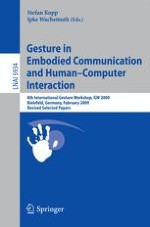The International Gesture Workshops (GW) are interdisciplinary events for those researching gesture-based communication across the disciplines. The focus of these events is a shared interest in understanding gestures and sign language in their many facets, and using them for advancing human–machine interaction. Since 1996, International Gesture Workshops have been held roughly every second year, with fully reviewed proceedings published by Springer. The International Gesture Workshop GW 2009 was hosted by Bielefeld University’s Center for Interdisciplinary Research (ZiF – Zentrum für interdisziplinäre Forschung) during February 25–27, 2009. Like its predecessors, GW 2009 aimed to provide a platform for participants to share, discuss, and criticize recent and novel research with a multidisciplinary audience. More than 70 computer scientists, linguistics, psychologists, neuroscientists as well as dance and music scientists from 16 countries met to present and exchange their newest results under the umbrella theme “Gesture in Embodied Communication and Human–Computer Interaction. ” Consistent with the steady growth of research activity in this area, a large number of high-quality submissions were received, which made GW 2009 an exciting and important event for anyone interested in gesture-related technological research relevant to human–computer interaction. In line with the practice of previous gesture workshops, presenters were invited to submit theirs papers for publication in a subsequent peer-reviewed publication of high quality. The present book is the outcome of this effort. Representing the research work from eight countries, it contains a selection of 28 thoroughly reviewed articles.
